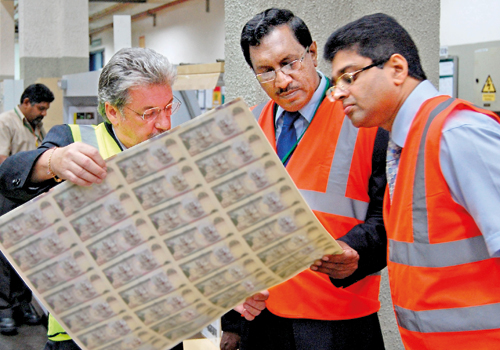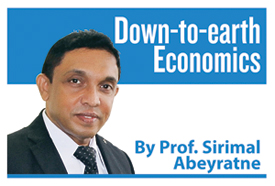Time for “helicopter money”
View(s):
File picture of currency printing at an out-of-Colombo facility.
Let us assume that one day a helicopter flying above drops hundreds of currency notes among the people across the country.
The money that falls from the sky is everywhere and people will wrestle and grapple to grab them. They know that this is a unique opportunity which is unlikely to happen again. As a result of the money from the sky, the amount of money in the country rises so much that people start spending freely this additional money in their hands.
The above story is not mine, although I used my own wording to explain it. This is how its author – Chicago economist Milton Friedman introduced the concept of “helicopter money” in 1969. The subject that we handle today is little heavy and, perhaps, that’s why even Friedman used the above simple theory to talk about it. And 50 years later, today the issue is even more complex than what was handled by Friedman at that time.
He was known to be a free-market economist who pioneered the monetarist school. Well, economists don’t stick labels to themselves; this is normally done by their opponents. Friedman coined the term “helicopter money” to explain how free money dropping from the sky into the hands of people results in building up inflation.
Money in excess
This is not a question about whether Friedman was right or wrong. He could be right under certain circumstances and wrong under different circumstances. This leaves something for economists to keep themselves busy in debating and discussing all the time and trying to prove that everyone else is wrong. However, Friedman had a valid point during the time he started writing about money – that is inflation! And inflation in the 1960s in the Western world – particularly the US and Europe, was a result of too much money.
Why did these countries push money growth excessively? The answer is in the historical context: During the post-war period, there was enough room for governments to spend and central banks to finance it in order to rebuild the war-torn and crisis-stricken US and European economies. The strategy went, perhaps, too far and too deep for about a quarter of a century. It produced growth too so that the Western countries experienced their golden era of economic growth in the 1950s and the 1960s. This means that money can produce economic growth too. Then it led to inflation which is also a result of too much money.
If money can produce both inflation and growth, we are then in a situation where the world needs both. The COVID-19- tormented and crisis-stricken world economy needs at least to avoid deflation and an economic fallout. According to OECD data, the economies of the US, the Eurozone, Japan, and the UK, have all contracted during the first quarter of 2020. On the other hand, they have also reported a sharp decline in their inflation rates during the past few months of the year, coming closer to zero.
Negative inflation and
negative growth
If the inflation rate goes below zero, it is called “deflation”, which is worse than inflation. In a deflationary situation, private spending becomes weaker as people and businesses tend to postpone their purchases. This would lower the demand for output – the so-called decline in aggregate demand, which in turn leads to a fall in output and, hence slower economic growth, fall in incomes and loss of jobs.
If pumping money can get the economies out of the impasse, there is no dispute this is the time to do that. Does it work, however? Again, there is no right or wrong answer providing economists’ room for debates and discussions to prove themselves. Let me elaborate on some of the issues to understand when it works and when it doesn’t.
Deflationary pressure and slower growth in the world economy were already there as the world economy was passing through two economic crises – global financial crisis in 2008/2009 and the current global economic crisis led by the COVID-19 pandemic issue. Therefore, money growth (accompanied by increased government spending) is not a new thing, as all major countries in the world have been pumping money recklessly.
During the period between the two economic crises (2008-2020), the US has increased the stock of money (calculated as M1) by more than three times and Eurozone by 2.5 times, while both Japan and the UK have doubled their money stock. In addition to helicopter money – that is the money that they pumped through the banks-, the central banks continued with purchasing the long-term government bonds back – the so-called quantitative easing-, and the tax-cuts, selling the resulting government debt to central banks.
Money from above
Strange enough, there was no pick-up in inflation or acceleration of economic growth, both in a sustainable manner. Didn’t people increase buying and stimulating demand after they grab the money dropping from the sky? It is a valid question, but in order to understand its gravity, it is also necessary to ask another unavoidable question: “In whose hands does that money end up?”
This time is different from Friedman’s time, now with new ways and means of spending helicopter money. While investing in financial assets has grown exponentially, moving money around the world using Internet technology and digital devices under new policy environments is a big turning point. If the money pumped into the banks ends up in the hands of investors in financial assets, then there is little impact on stimulating aggregate demand causing inflation and growth. In fact, due to near-zero interest rates in advanced countries, isn’t it a rational choice to borrow cheap and invest in lucrative stock markets and bond markets? After all, it has nothing to do with reviving the economy and inflation as anticipated with helicopter money.
 In the developing countries where offshore money flows are restricted by regulations and where the stock markets, bond markets, and capital markets are not yet developed, the question begs to be asked as to where this helicopter money ends up in. Obviously, the liquidity should find the lower grounds to flow into.
In the developing countries where offshore money flows are restricted by regulations and where the stock markets, bond markets, and capital markets are not yet developed, the question begs to be asked as to where this helicopter money ends up in. Obviously, the liquidity should find the lower grounds to flow into.
The money that comes to the banks does not flow outside the country because the capital accounts are not liberalised which means that money should remain within the country. Part of that goes to the hands of the private sector – consumers and producers both. And this is the very purpose of the helicopter money, but for that matter the borrowers should be eligible to get access to bank credit. In underdeveloped capital and money markets, it is a problem that due to various structural weaknesses and market rigidities everybody is not competitive enough to have access to bank loans unless there is a bank guarantee. Especially in crisis times, as the non-performing loans are on the rise, banks are likely to take extra precautions in lending.
Risky-lending or safe-deposits?
Banks, anyway, have an option to go for either risky-lending or safe-deposits in order to dispose of excess liquidity, caused by helicopter money. Usually in developing countries, interest rates remain much higher than those in advanced countries where the rates have fallen to near-zero levels. This means that the money pumped by the central banks can be reversed to the central banks themselves as commercial bank deposits. And this is lucrative as money that dropped freely can be converted into interest-bearing assets with no risks involved in it.
By the way, even if it doesn’t happen, helicopter money can backfire too, by lowering the interest rates and weakening the exchange rates under different circumstances. More money that leads to greater demand for financial assets would lower the interest rates. Both more money and lower interest rates would force foreign exchange outflows causing exchange rate depreciation. In such a situation, you need market controls to contain both.
(The writer is a Professor of Economics at the University of Colombo and can be reached at sirimal@econ.cmb.ac.lk).


